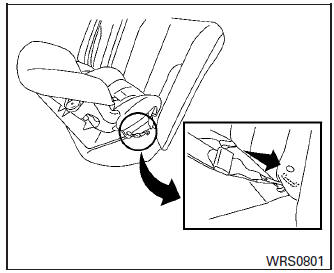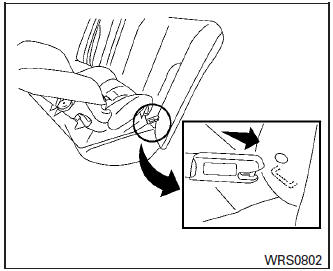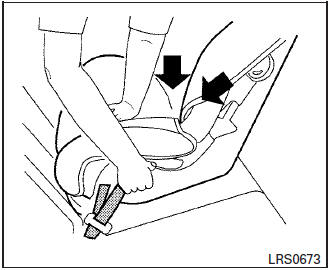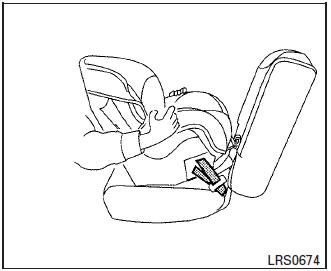Nissan Rogue Owners Manual: Rear-facing child restraint installation using LATCH
For additional information, refer to all Warnings and Cautions in the ŌĆ£Child SafetyŌĆØ and ŌĆ£Child RestraintŌĆØ sections before installing a child restraint.
NISSAN does not recommend the use of the lower anchors if the combined weight of the child and the child restraint exceeds 65 lbs (29.5 kg). If the combined weight of the child and the child restraint is greater than 65 lbs (29.5 kg), use the vehicleŌĆÖs seat belt (not the lower anchors) to install the child restraint. Be sure to follow the child restraint manufacturerŌĆÖs instructions for installation.
Follow these steps to install a rear-facing child restraint in the 2nd row seats using the LATCH system:
- Position the child restraint on the seat. Always follow the child restraint manufacturerŌĆÖs instructions.

Rear-facing webbing-mounted ŌĆō step 2
- Secure the child restraint anchor attachments to the LATCH lower anchors. Check to make sure the LATCH attachment is properly attached to the lower anchors.

Rear-facing rigid-mounted ŌĆō step 2

Rear-facing ŌĆō step 3
- For child restraints that are equipped with
webbing-mounted attachments, remove any
additional slack from the anchor attachments.
Press downward and rearward firmly in the center of the child restraint with your hand to compress the vehicle seat cushion and seatback while tightening the webbing of the anchor attachments.

Rear-facing ŌĆō step 4
- After attaching the child restraint, test it before you place the child in it. Push it from side to side while holding the child restraint near the LATCH attachment path. The child restraint should not move more than 1 inch (25 mm), from side to side. Try to tug it forward and check to see if the LATCH attachment holds the restraint in place. If the restraint is not secure, tighten the LATCH attachment as necessary, or put the restraint in another seat and test it again. You may need to try a different child restraint or try installing by using the vehicle seat belt (if applicable). Not all child restraints fit in all types of vehicles.
- Check to make sure the child restraint is properly secured prior to each use. If the child restraint is loose, repeat steps 2 through 4.
 LATCH (Lower Anchors and Tethers for CHildren) System
LATCH (Lower Anchors and Tethers for CHildren) System
LATCH system lower anchor locations - bench seat
Your vehicle is equipped with special anchor
points that are used with LATCH system compatible
child restraints. This system may also be
referr ...
 Rear-facing child restraint installation using the seat belts
Rear-facing child restraint installation using the seat belts
Rear-facing child restraint installation using the seat belts
WARNINGThe three-point seat belt with Automatic
Locking Retractor (ALR) must be used
when installing a child restraint. ...
Other materials:
Brakes
If the brakes do not operate properly, have the
brakes checked by a NISSAN dealer.
Self-adjusting brakes
Your vehicle is equipped with self-adjusting
brakes.
The front and rear disc-type brakes self-adjust
every time the brake pedal is applied.
WARNINGSee a NISSAN dealer for a brake ...
Oil
Description
MAINTENANCE OF OIL LEVEL
The compressor oil is circulating in the system together with the
refrigerant. It is necessary to fill compressor
with oil when replacing A/C system parts or when a large amount of refrigerant
leak is detected. It is important
to always maintain oil level ...
B00A0 OCS system
Description
DTC B1017, B1018, B1020, B1021, B1022, B1025, B1032, B1048 OCCUPANT
CLASSIFICATION
SYSTEM (OCS)
The OCS control unit is wired to the air bag diagnosis sensor unit. The air
bag diagnosis sensor unit will monitor
the OCS for failures and interruptions in communication between the O ...
